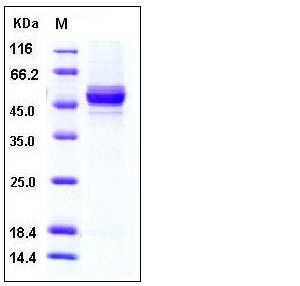Rat GPT2 Protein (His Tag)
ALT2, Cc2-5, Gpt2
- 100ug (NPP2852) Please inquiry
| Catalog Number | P80002-R08B |
|---|---|
| Organism Species | Rat |
| Host | Baculovirus-Insect Cells |
| Synonyms | ALT2, Cc2-5, Gpt2 |
| Molecular Weight | The recombinant rat Gpt2 comprises 532 amino acids with a predicted molecular mass of 55 kDa. It migrates as an approximately 48 kDa band in reduced SDS-PAGE. |
| predicted N | Met 1 |
| SDS-PAGE |  |
| Purity | > 95 % as determined by SDS-PAGE |
| Protein Construction | A DNA sequence encoding the rat Gpt2 (NP_001012057.1) (Met 1-Ser 522) with a C-terminal polyhistidine tag was expressed. |
| Bio-activity | |
| Research Area | Developmental Biology |Metabolism |Pathways and Processes |Metabolic signaling pathways |Amino acid metabolism |
| Formulation | Lyophilized from sterile 50mM Tris, 100mM NaCl, pH 8.0, 10% glycerol, 0.5mM TCEP 1. Normally 5 % - 8 % trehalose, mannitol and 0.01% Tween80 are added as protectants before lyophilization. Specific concentrations are included in the hardcopy of COA. |
| Background | Alanine aminotransferase (ALT), also known as glutamate pyruvate transaminase (Gpt), is a pyridoxal enzyme which catalyses the reversible interconversion of L-alanine and 2-oxoglutalate to pyruvate and L-glutamate, and plays a key role in the intermediary metabolism of glucose and amino acids. As a key enzyme for gluconeogenesis, Gpt is a widely-used serum marker for liver injury. Two ALT isoenzymes have been identified, ALT1 and ALT2 (GPT1 and GPT2), which are encoded by separate genes and share significant sequence homology, but differ in their expression patterns. Gpt1 is widely distributed and mainly expressed in intestine, liver, fat tissues, colon, muscle, and heart, in the order of high to low expression level, whereas Gpt2 expression is more restricted, mainly in liver, muscle, brain, and white adipose tissue. It has been reported that hepatic ALT2 protein is approximately four times higher in male rats than in female rats. |
| Reference |
